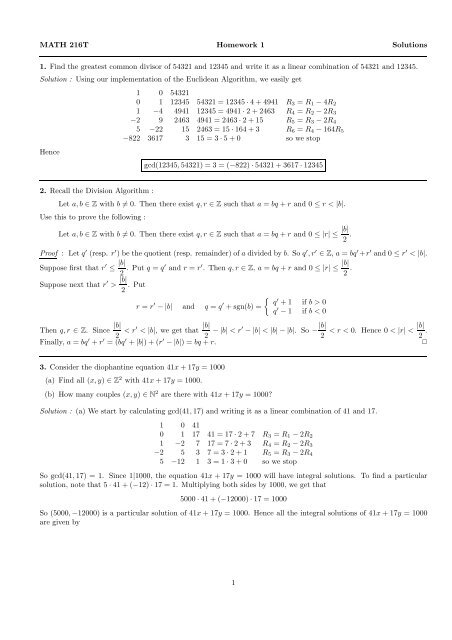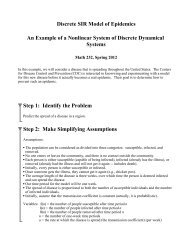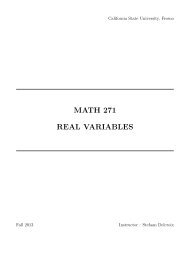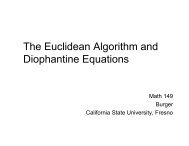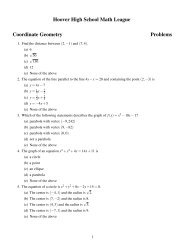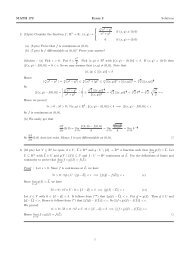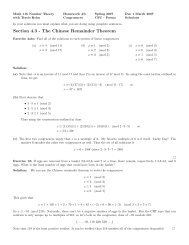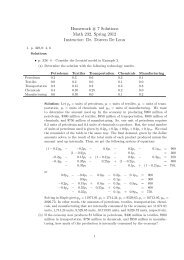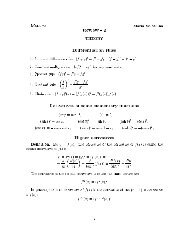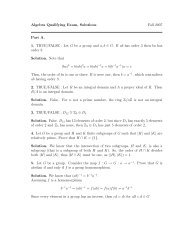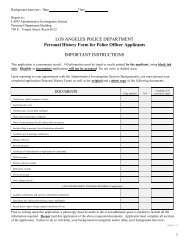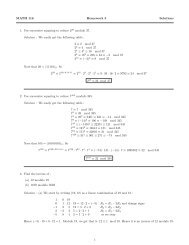MATH 216T Homework 1 Solutions 1. Find the greatest common ...
MATH 216T Homework 1 Solutions 1. Find the greatest common ...
MATH 216T Homework 1 Solutions 1. Find the greatest common ...
You also want an ePaper? Increase the reach of your titles
YUMPU automatically turns print PDFs into web optimized ePapers that Google loves.
{x = 5000−17ty = −12000+41twhere t ∈ Z(b) We are interested in finding <strong>the</strong> solutions where x and y are positive. So5000−17t ≥ 0 and −12000+41t ≥ 0Hence we gett ≤ 5000 12000≈ 294.12 and t ≥ ≈ 292.6817 41Since t is an integer, we get that t ∈ {293,294}.There are only two couples (x,y) ∈ N 2 with 41x+17y = 10004. Nadir Airways offers three types of tickets on <strong>the</strong>ir Boston-new York flights. First-class tickets are $140, secondclasstickets are $110 and stand-by tickets are $78. If 69 passengerspay a total of $6548 for <strong>the</strong>ir tickets on a particularflight, how many of each type of ticket were sold? Show your work! Going over all combinations will not receive credit!Solution : Let x (resp. y and z) be <strong>the</strong> number first-class (resp. second-class and stand-by) tickets sold. Then wehave⎧⎨ x+y +z = 69 (1)140x+110y+78z = 6548 (2)⎩x,y,z ∈ NFirst, we find all integral solutions to (1) and (2). Solving (1) for z and substituting <strong>the</strong> result in (2), we get{z = 69−x−y140x+110y+78(69−x−y) = 6548or{ z = 69−x−y62x+32y = 1166We know how to find all <strong>the</strong> integral solutions of 62x+32y = 1166. Dividing both sides by 2, we get31x+16y = 583We start by calculating gcd(31,16) and writing it as a linear combination of 41 and 17.1 0 310 1 16 31 = 16·2+(−1) R 3 = R 1 −2R 2 and change signs−1 2 1 16 = 1·16+0 so we stopSo gcd(31,16) = <strong>1.</strong> Since 1|583, <strong>the</strong> equation 31x + 16y = 583 will have integral solutions. To find a particularsolution, note that (−1)·31+2·16 = <strong>1.</strong> Multiplying both sides by 583, we get that(−583)·31+1166·16 = 583So (−583,1166) is a particular solution of 31x+16y = 583. Hence all <strong>the</strong> integral solutions of 31x+16y = 583 aregiven by{ x = −583+16twhere t ∈ Zy = 1166−31t{ x+y +z = 69Substituting this result in <strong>the</strong> expression for z, we find that all <strong>the</strong> integral solutions of140x+110y+78z = 6548are given by⎧⎨ x = −583+16ty = 1166−31t where t ∈ Z⎩z = −514+15t2
Since we are interested in natural solutions, we must have that x ≥ 0, y ≥ 0 and z ≥ 0. Hence−583+16t ≥ 0 and 1116−31t ≥ 0 and −514+15t ≥ 0Sot ≥ 5831166= 36.4375 and t ≤16 31Since t ∈ Z, we must have that t = 37. Hence≈ 37.6 and t ≥51415 ≈ 34.3x = −583+16·37 = 9 , y = 1166−31·37 = 19 and z = −514+15·37 = 419 first-class tickets, 19 second-class tickets and 41 stand-by tickets were sold.5. Let a,b ∈ N 0 with a 3 |b 2 . Use unique prime factorization to prove that a|b.Proof : Puta = p α11 pα2 2 ···pα kkand b = p β11 pβ2 2 ···pβ kkwhere k is a positive integer, p 1 < p 2 < ··· < p k are primes and α i ,β i are nonnegative integers for i = 1,2,...,k.ThenSince a 3 divides b 2 , we get thatSoa 3 = p 3α11 p 3α22 ···p 3α kksince β i ≥ 0 for i = 1,2,...,k.Buta = p α11 pα2 2 ···pα kkSince α i ≤ β i for i = 1,2,...,k, we get that a divides b.and b 2 = p 2β11 p 2β22 ···p 2β kk3α i ≤ 2β i for i = 1,2...,kα i ≤ 2 3 β i ≤ β i for i = 1,2,...,kand b = p β11 pβ2 2 ···pβ kk✷6. Let a,b,c ∈ N 0 with gcd(a,b) = <strong>1.</strong>(a) Let r > 0. Prove that <strong>the</strong> line ax+by = c intersects <strong>the</strong> circle x 2 +y 2 = r 2 in two different points if and only ifcr > √a2 +b 2.(b) Prove that <strong>the</strong> equation ax+by = c has a solution (x 0 ,y 0 ) ∈ Z 2 such thatx 2 0 +y0 2 ≤ c2a 2 +b 2 + a2 +b 24Proof : (a) There will be one point of intersection if <strong>the</strong> line is tangent to <strong>the</strong> circle. We have <strong>the</strong> following picture :❩Y❩❩❩❩❩❩❩❩❩❩❩❩❩✻x 2 +y 2 = r 2 ax+by = c✲ X3
( c)(We easily get that <strong>the</strong> X-intercept of ax+by = c isa ,0 while <strong>the</strong> Y-intercept is 0, c ). HencebP(0, c b )❩ ❩❩❩❩❩❩❩❩❩❩❩Rr✓ ✓✓✓✓✓O(0,0)Q( c a ,0)Using similar triangles, we get that |OR||OQ| = |OP||PQ| . Hencer = |OR| = |OQ|·|OP||PQ|=√ (caca · cb) 2 (+c)= ··· =2bc√a2 +b 2Hence <strong>the</strong> line ax+by = c will intersect <strong>the</strong> circle x 2 +y 2 = r 2 in two different points if and only if r >c√a2 +b 2.Note that we can get this result pure algebraically. There are two points of intersection if and only if <strong>the</strong> system{ ax+by = c (1)x 2 +y 2 = r 2 (2)has two solutions. It follows from (1) that y = c−ax . Substituting this into (2), we findb( ) 2 c−axx 2 + = r 2bor(a 2 +b 2 )x 2 −2acx+c 2 −b 2 r 2 = 0This quadratic equation is x has two solutions if and only if it’s discriminant is strictly positive :(−2ac) 2 −4(a 2 +b 2 )(c 2 −b 2 r 2 ) > 0Solving for r 2 , we get r 2 > c2a 2 +b 2.√c2(b) Put r =a 2 +b 2 + a2 +b 2. Since r >4x 2 +y 2 = r 2 in two different points, say P 1 (x 1 ,y 1 ) and P 2 (x 2 ,y 2 ). Suppose we can prove that <strong>the</strong> distance d betweenP 1 and P 2 is at least √ a 2 +b 2 . Then it follows from what we have seen in class that <strong>the</strong>re exists a couple (x 0 ,y 0 ) ∈ Z 2such that ax 0 + by 0 = c and <strong>the</strong> point P(x 0 ,y 0 ) belongs to <strong>the</strong> line segment P 1 P 2 . Hence P lies inside <strong>the</strong> circlex 2 +y 2 = r 2 . Soc√ it follows from (a) that <strong>the</strong> ax+by = c will intersect <strong>the</strong> circlea2 +b2, x 2 0 +y0 2 ≤ r 2 = c2a 2 +b 2 + a2 +b 24It remains to prove that d ≥ √ a 2 +b 2 . This is equivalent to showing that d 2 ≥ a 2 +b 2 .We have <strong>the</strong> following picture :4
Yax+by = c ❍ ❍❍❍❍❍❍❍❍❍❍❍❍❍❍❍❍❍❍❍✻x 2 +y 2 = r 2 P 1P 2✁ ✁ ✁ ✁ RO✲ XorP 1rRrOcIt follows from (a) that |OR| = √ Hencea2 +b2. ( cd 2 = 4|RP 1 | 2 = 4(r 2 −|OR| 2 2) = 4a 2 +b 2 + a2 +b 2 )− c24 a 2 +b 2 = a 2 +b 2P 2Again, we can derive this result algebraically. Using <strong>the</strong> Distance Formula, we get thatd 2 = (x 2 −x 1 ) 2 +(y 2 −y 1 ) 2Note that (x 1 ,y 1 ) and (x 2 ,y 2 ) are <strong>the</strong> solutions of{ax+by = c (1)x 2 +y 2 = r 2 (2)It follows from (1) that y = c−ax . Substituting this into (2), we findborHenceSo( ) 2 c−axx 2 + = r 2b(a 2 +b 2 )x 2 −2acx+c 2 −b 2 r 2 = 0x 1 ,x 2 = ac±√ (ac) 2 −(a 2 +b 2 )(c 2 −b 2 r 2 )a 2 +b 2 = ··· = ac± 1 2 b(a2 +b 2 )a 2 +b 2(x 2 −x 1 ) 2 =( ac+12 b(a2 +b 2 )a 2 +b 2 − ac− 1 2 b(a2 +b 2 )2)a 2 +b 2 = b 25
Similarly, we get that (y 2 − y 1 ) 2 = a 2 (so we would solve (1) for x and substitute into (2); this comes down tointerchanging a and b). Henced 2 = (x 2 −x 1 ) 2 +(y 2 −y 1 ) 2 = b 2 +a 2✷6


